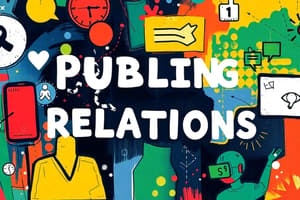Podcast
Questions and Answers
What are the main purposes of public relations?
What are the main purposes of public relations?
The main purposes of public relations are to help organizations communicate with their stakeholders and to portray the brand in the best possible manner.
What are the differences between public relations and advertising?
What are the differences between public relations and advertising?
Public relations is earned media, whereas advertising is paid media. A good PR story is more effective than a full-page ad.
How do public relations professionals contribute to a company's management?
How do public relations professionals contribute to a company's management?
PR professionals are part of the management of a company, shaping its image and strategy, unlike marketing which is more sales-focused.
What skills are crucial in public relations campaigns?
What skills are crucial in public relations campaigns?
What is the ultimate goal of both advertising and public relations?
What is the ultimate goal of both advertising and public relations?
What are the key concepts of public relations?
What are the key concepts of public relations?
What are the various models of public relations mentioned in the text?
What are the various models of public relations mentioned in the text?
What historical examples of public relations are mentioned in the text?
What historical examples of public relations are mentioned in the text?
What is the 'Battle of the Currents' and its relevance to public relations?
What is the 'Battle of the Currents' and its relevance to public relations?
How did P.T. Barnum use public relations to generate positive stories about his circus?
How did P.T. Barnum use public relations to generate positive stories about his circus?
Flashcards are hidden until you start studying
Study Notes
Public Relations: Key Concepts and Historical Examples
- Public relations involves targeting different audiences, known as "publics," and ensuring their satisfaction.
- Public relations professionals work to communicate messages to the public, including stakeholders and the media.
- Various models of public relations include traditional, public information, persuasive communication, and two-way symmetric models.
- The history of public relations dates back to ancient Rome and China, where leaders used communication strategies to avoid conflict.
- The Boston Tea Party is cited as an example of a famous PR stunt, a staged event to attract media and public attention.
- Westinghouse and General Electric engaged in the "Battle of the Currents," utilizing public relations to gain an edge over each other.
- P.T. Barnum leveraged earned media by inviting reporters to his circus for free, generating positive stories without paid advertising.
- Railroads engaged in unethical practices by paying reporters to write favorable reports, known as "deadheading," which is considered media bribery today.
- Public relations professionals are sometimes viewed negatively by journalists due to their role in shaping and controlling information.
- The text mentions the four models of public relations: traditional, public information, persuasive communication, and two-way symmetric models.
- The history of public relations includes examples of ancient leaders using communication strategies to avoid conflict.
- The Boston Tea Party is cited as an example of a famous PR stunt, a staged event to attract media and public attention.
Studying That Suits You
Use AI to generate personalized quizzes and flashcards to suit your learning preferences.




